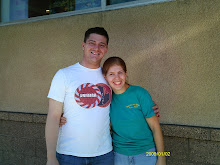Three weeks ago, my TR8 class read a recipe for traditional Irish soda bread as part of their
TIME for Kids nonfiction reading curriculum. Months before I had collected the ingredients for another ethnic dish taken from the magazine, a fruit salad from from Pakistan, and led the class in preparing the food. Remembering our culinary experiment, Betty piped up, "Teacher, can we make this?"
I was a bit caught off guard. I had none of the ingredients in which to make the recipe that day, having had only the shortest sliver of time between morning and afternoon classes to prepare. However, I did agree with her: I thought it sad that my students could only read about such an exciting activity as bread-making instead of participating in it. "I'll ask Teacher Grace about it," I intoned. "Maybe next Wednesday or Friday."
"Teacher," Ben asked excitedly the following Wednesday. "Today...? You said we make bread next Wednesday or Friday." I smiled at his exuberance and told him that Teacher Grace had said we could do it for the activity day scheduled at the end of the month. And thus Irish Bread Cooking Day with Teacher Jennifer was born.
As long as we were making bread with the elementary students, Grace suggested we do it a week early with the kindergarten as our last cooking day of the school year. I thought that was a great idea and assured her it would be fairly simple to make with the kids, provided that all the ingredients were present and students listened well; it could even be fun. "I can find caraway seeds and baking soda in Seoul," I told her. "The only thing we can't find in Korea is [the] buttermilk, but I can make that."
"You put it together," Grace said calmly, "and I will support you."
The afternoon of the kindergarten's cooking adventure, for the first time since starting to eat lunch with them last March, I left three of my pre-kinder students to finish their meal on their own while I made preparations for class. During my break earlier in the day, I had arranged the six thigh-high tables in K-2's room to look like a long, anvil-shaped workbench, and moved in a larger waist-high table to act as kitchen countertop.
While my students ate, I organized and collected my supplies: seven bowls for each student to add his respective ingredient; a larger bowl for the eight cups of flour needed for the dough; and a great big bowl for mixing. I then divvied up the bread's raw materials into the smaller bowls and waited for my students. After the bell rang, I asked the kids to wash their hands and don their aprons and hair scarves, then to sit in front of the different bowls spread out on the table. I wasn't caught off guard this time. And this cooking class was gonna rock!
For our first item of business after the students settled in, I asked Julia to plop a tablespoon of flour onto the cutting board. After she spread it around ineffectively with the back of the tablespoon, I took my fingers to it and massaged it over the board. "Teacher, it is messy," I heard Christine assert.

"That's okay," I smiled her as I patted my flour-dusted hands on my jeans. "I'll get messier."
One by one, starting with Jake to my left and going around the table counter-clockwise, each student had the chance to add their ingredient to the mixture: Jake and Rachel, four bowl-fulls of flour; Julia, sugar; Lisa, baking powder; Irene, the caraway seeds. As I stirred the tiny dark green grains into the smooth white texture, I smiled to myself. "They look like ants," I told my students. Elena brought me slightly larger ants, the raisins.
Next came Christine's buttermilk, Julia's and Rachel's eggs, and the baking soda, wet ingredients to be mixed in a separate bowl and folded into the flour. "Simon," I bellowed, trying to be just harsh enough to be obeyed. "Bring your bowl." His was the last ingredient to be added, as he had spent the last several minutes sitting outside the room because of his inattention. Yet even naughty boys needed second chances: He picked up his bowl absently and wandered to the inverted V-shape of the front end of the table, dumping his baking soda into the sticky liquid mixture.
After everything had been added, my students and I went to work congealing the milky substance into bread. I called each student by name to help mix the wet and dry ingredients together with their elbow grease, not wanting anyone to miss out on the fun part. When the dough was firm enough and each had had his chance to stir, I pulled the moist lump apart with my hands to form two sizable loaves; these would in turn be shaped into smaller balls of muffin-sized soda bread for them to take home. One by one, the students stood at the thick, wooden cutting board to knead the large lumps, what would become their own little peice of bread dough.

"We should open a bakery," Grace told me at the close of class while we oversaw the last of the Irish buscuits baking in the oven.
I smiled to myself at her comment. It wasn't so unheard of, I knew: Earlier this year, my oldest students had read a fictionalized account, inspired by true events, of a girl doing just that during the California Gold Rush of the 1840s. A
waegukin like myself might have a lucrative niche selling plump, grainy bread in a place whose only idea of it is more like Mexico's
pan dulce [sweet bread] than Nature's Own whole- or honey-wheat.
Still, with as much fun as baking with the kids had turned out to be, perhaps in the end I'm better off just teaching them. I had quite a reaction from my K-2 students when they'd finally had a chance to taste their creation. "Teacher, the bread is not yummy," Rachel said the following morning. "My sister and my mother and my baby brother eat it, but I don't eat. Not good smell."
"Because of ants," Christine chimed.
As I listened to my students' critiques, I remembered Cook Jane's advice as she sampled a piece of the bread before taking the students home the previous day. "
Sonsangnim," she had told Grace in Korean, "if it's for the kids, it needs more sugar." To my developed, adult palate, the half cup it already contained was sweetener enough--surely, it couldn't have needed
more than that.
Yet, if being sweet is what they understand bread to be, sugar was precisely what the soda bread lacked for my students. The thing that will make or break a bakery--and indeed, a recipe--is the tastes of its customers. Perhaps what I really need to be in tuned with is not my own palate, but a Korean one.




















 For St. Patrick's Day, the "Irish of the Orient" treated me to the best Patty's party I've ever attended: Green was in abundance, dancing was the flavor of the day, and St. Patrick (a.k.a. Our James Teacher) himself graced us with his celebrated presence.
For St. Patrick's Day, the "Irish of the Orient" treated me to the best Patty's party I've ever attended: Green was in abundance, dancing was the flavor of the day, and St. Patrick (a.k.a. Our James Teacher) himself graced us with his celebrated presence. 

 On the fiftth of April, the day Koreans celebrate Arbor Day, my kindergarten students went for a short field trip to a local park to plant tree seeds. The air was fresh, the weather breezy, and the sun warm--the makings of a fine spring day by Texas standards. The Koreans, however, didn't seem to be expecting it: My students came dressed for the elements that day, complete with jackets, warm-up suits, and three layers underneath. My K-1 student, Harry, looked at me after he had just been running around in all those clothes and said, "Teacher, hot." Why, naturally.
On the fiftth of April, the day Koreans celebrate Arbor Day, my kindergarten students went for a short field trip to a local park to plant tree seeds. The air was fresh, the weather breezy, and the sun warm--the makings of a fine spring day by Texas standards. The Koreans, however, didn't seem to be expecting it: My students came dressed for the elements that day, complete with jackets, warm-up suits, and three layers underneath. My K-1 student, Harry, looked at me after he had just been running around in all those clothes and said, "Teacher, hot." Why, naturally.



























